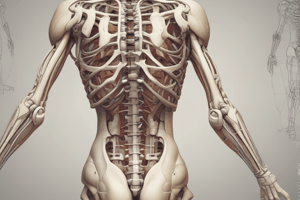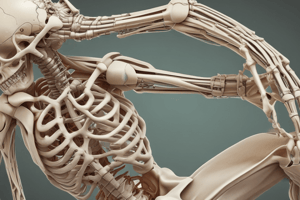Podcast
Questions and Answers
Which of the following are types of synovial joints? (Select all that apply)
Which of the following are types of synovial joints? (Select all that apply)
- Hinge (correct)
- Saddle (correct)
- Planar (correct)
- Ball-and-socket (correct)
- Pivot (correct)
- Condyloid (correct)
What type of joint allows gliding movement?
What type of joint allows gliding movement?
Planar joint
What is an example of a hinge joint?
What is an example of a hinge joint?
Elbow joint
What describes a pivot joint?
What describes a pivot joint?
What is a characteristic of a condyloid joint?
What is a characteristic of a condyloid joint?
Where is a saddle joint found?
Where is a saddle joint found?
Which joints are classified as ball-and-socket joints?
Which joints are classified as ball-and-socket joints?
Flashcards are hidden until you start studying
Study Notes
Six Types of Synovial Joints
- Synovial joints are categorized into six types based on their structure and range of motion: planar, hinge, pivot, condyloid, saddle, and ball-and-socket.
Planar Joint
- Consists of two flat surfaces allowing gliding movements.
- Examples include the joints between carpal bones in the wrist and the joint between the mandible and temporal bone, enabling forward and backward movement.
Hinge Joint
- Functions similarly to a door hinge, allowing motion in one direction (flexion and extension).
- Common examples are the elbow joint and the interphalangeal joints of the fingers.
Pivot Joint
- Allows for rotational movement where one bone revolves around another.
- A prime example is the connection between the radius and ulna with the humerus, facilitating rotational movements.
Condyloid Joint
- Allows movements in various directions except for rotation.
- Found in knuckle joints and wrist joints, enabling flexion, extension, and side-to-side movements.
Saddle Joint
- Permits grasping and rotation, accommodating diverse movements.
- Notable example includes the joints at the base of each thumb, enhancing hand functionality.
Ball-and-Socket Joint
- Provides multidirectional movement along with rotation.
- Key examples are the hip and shoulder joints, allowing a wide range of motion.
Studying That Suits You
Use AI to generate personalized quizzes and flashcards to suit your learning preferences.





